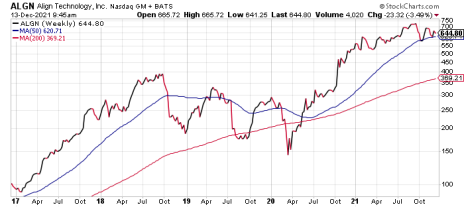Both early-stage stocks and late-stage stocks have a place in your portfolio. But to do that, you have to handle them very differently.
Today’s column is about what to do with late-stage stocks and early-stage stocks. But I’m going to start with a “don’t” for you to keep in mind.
Don’t Buy (or Sell) the News
It concerns the news—specifically, you shouldn’t obsess over it, at least when you’re talking about news that affects the overall market.
Recent headlines have been dominated by the omicron variant, persistent inflation and the action (or lack thereof) by the Fed.
Next week, maybe it’ll be something else.
When it comes to the market, it’s going to do what it’s going to do—and then the press will assign reasons to explain the move. The media can’t just say, “The market was down 1% today because there were more sellers than buyers,” even though that’s often the case.
More important for investors is that the news tends to describe the past and the present—it has little predictive ability. Unfortunately, though, after a few months of negative headlines, what do most investors focus on? The (bad) news! That causes many to miss out on the eventual turn.




Long story short, it’s fine to be aware of the news, and feel free to talk about or debate it at the dinner table. But when it comes to the market, it’s not the news that counts, it’s the market’s reaction to the news and its overall tenor.
And, by the way, this goes for all types of news—good economic or earnings news doesn’t automatically mean good things. It’s all about the market’s (or stock’s) reaction to that news.
Late-Stage Stocks vs. Early-Stage Stocks
With that out of the way, I wanted to tackle one of the more popular types of questions I’ve gotten recently. It concerns a popular but “late-stage” stock—i.e., stocks that have had big runs over many months or years and are relatively obvious to the investing crowd—and what to do with it.
A good example is Align Technology (ALGN), whose Invisalign braces have driven fantastic growth for many years.
Given the stock’s nice consolidation in 2019, the solid upmove off the pandemic lows (the stock is up 345% since March 2020) and the resilience since, there’s still a case to be made for further growth in this late-stage stock. However, it’s good to keep in mind ALGN’s action during the past few years, too.
A look at the five-year chart below shows that ALGN has already enjoyed a huge, prolonged run. By my system, the original breakout occurred in March 2016 when the stock was around 70, so the stock is up nine-fold from that point!
Given the run, it’s fair to say this isn’t an early-stage stock. At the very least, the stock is likely to be subject to more whippy action as traders and weak holders react to every piece of news for the company or the market. And, worst-case scenario, shares could be near the end of their overall move.
If you own late-stage stocks, it’s usually better to handle them with a bit of a tighter leash than something that’s just blasting off for the first time. That might mean buying a smaller position. Or (my preferred way) it could mean taking partial profits on the way up (selling one-third of your shares when the stock is up a decent amount) and simply trailing a stop for the rest.
To be clear, there’s nothing that says ALGN can’t motor higher for another few months—the recent strength and consolidation suggests it could. But it’s good to be cognizant of where the stock is in its overall run.
For ALGN, the odds favor it being in the later innings of its advance, so it’s prudent to take a bit more of a trader-like approach with part of your shares.
What about so-called early-stage situations, where a stock has just taken off?
In those cases, it’s the opposite—you generally want to be a bit more lenient after you enter the position, possibly even taking a slightly smaller position (and using a slightly looser stop) to give the stock every chance to move higher over time. Of course, this assumes the stock has excellent fundamentals and has decisively gotten going on the upside.
Clearly, there’s a chance that ALGN does well for another year and any number of early-stage stocks craps out. But bigger picture, your portfolio will usually do better if you handle early-stage stocks and late-stage stocks a bit differently—a little more rope for early-stage stocks, and less so for late-stage stocks that have already had huge, prolonged advances.
For additional leading stocks that you can add to your portfolio, consider trying Cabot Top Ten Trader, which features market leaders you can latch on to for big profits. Click here to learn more.
Do you handle your late- and early-stage stocks differently? What’s your strategy for each?

Learn More

Learn More

Learn More

Learn More
*This post has been updated from a previous version.


